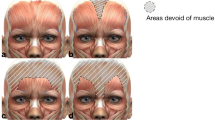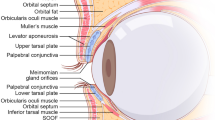Summary
In the past 3 years, 85 basal cell carcinomas were treated in our clinic using eyelid reconstruction. During the same period, 54 lids were reconstructed after other diseases, mostly after chemical burns. In one of the 54 patients, the upper lid was reconstructed using a tarso-marginal graft after congenital coloboma.
Method: In 31 of the 85 patients with basal-well carcinoma (36 %), so much tarsus was lost that a transplantation of tarsus was necessary. Fifteen of the 31 patients were treated with a Hughes-plasty and 16 using a tarsomarginal graft, two in the upper lid.
Results: In eight of the remaining 16 cases, the defect was less than one half of length, so that the graft was taken from the second lower lid. In the remaining eight patients, the defect was two thirds of length or longer. In six cases, a 7 mm-graft was taken from the upper lid. As the tarsus from the upper lid measures 10 mm and is thus twice as big as the lower lid tarsus, it was divided into two grafts, resulting in two grafts measuring 7 × 5 mm. They were placed in the lower lid (“double tarsomarginal graft”). The former lower part with lashes was placed in the middle of the lower lid, the former upper part peripherally. In two patients, the defect was healed with three tarsomarginal grafts. A pedicle skin flap was transposed to cover the posterior grafts. Remaining defects were closed with free skin transplants.
Conclusion: The tarsomarginal graft permits a short operation time and early rehabilitation of the patients. The disadvantage of the double tarsomarginal graft is that the more valuable upper lid tarsus is used to reconstruct the less valuable lower lid tarsus.
Zusammenfassung
Hintergrund: In den letzten 3 Jahren wurden an unserer Klinik bei 85 Patienten nach Basaliomexzision die Lider rekonstruiert. Im gleichen Zeitraum wurden 54 Lider nach anderen Grunderkrankungen rekonstruiert, meistens nach Verätzungen und Verbrennungen. Einer dieser 54 Patienten erhielt eine Oberlidrekonstruktion bei kongenitalem Kolobom mit einem Tarsomarginaltransplantat.
Methode: Bei 31 der 85 Patienten mit Basaliom (36 %) war der Tarsusdefekt so groß, daß eine Tarsustransplantation notwendig war. 15 der 31 Patienten erhielten eine Landoldt-Hughes-Plastik, 16 tarsomarginale Transplantate, davon 14 im Unter- und 2 im Oberlid.
Ergebnisse: Die Operationstechniken der 17 Tarsomarginaltransplantate waren 9mal Einfachtransplantate bei Exzisionsgrößen zwischen 8 und 12 mm. Bei 1 Patienten haben wir ein einfaches Tarsomarginaltransplantat mit Kantholyse bei einem Exzidat von 16 mm vorgenommen. Da das Unterlid dadurch zu sehr geschwächt wurde, mußte später eine Revision wegen Narbenektropium durchgeführt werden. Bei 6 Patienten war ein Zweifachtransplantat nötig (Exzidatgröße 15–17 mm). Zwei Patienten erhielten ein Dreifachtransplantat (Exzidatgröße 23 mm).
Schlußfolgerung: Das Tarsomarginaltransplantat bietet sich als universelle Methode zur Rekonstruktion von sowohl Ober- als auch Unterliddefekten jeder Größe an.
Similar content being viewed by others
Author information
Authors and Affiliations
Rights and permissions
About this article
Cite this article
Eusterholz, T., Wenzel, M. Eyelid reconstruction with tarsomarginal grafts. Ophthalmologe 94, 745–750 (1997). https://doi.org/10.1007/s003470050198
Published:
Issue Date:
DOI: https://doi.org/10.1007/s003470050198




